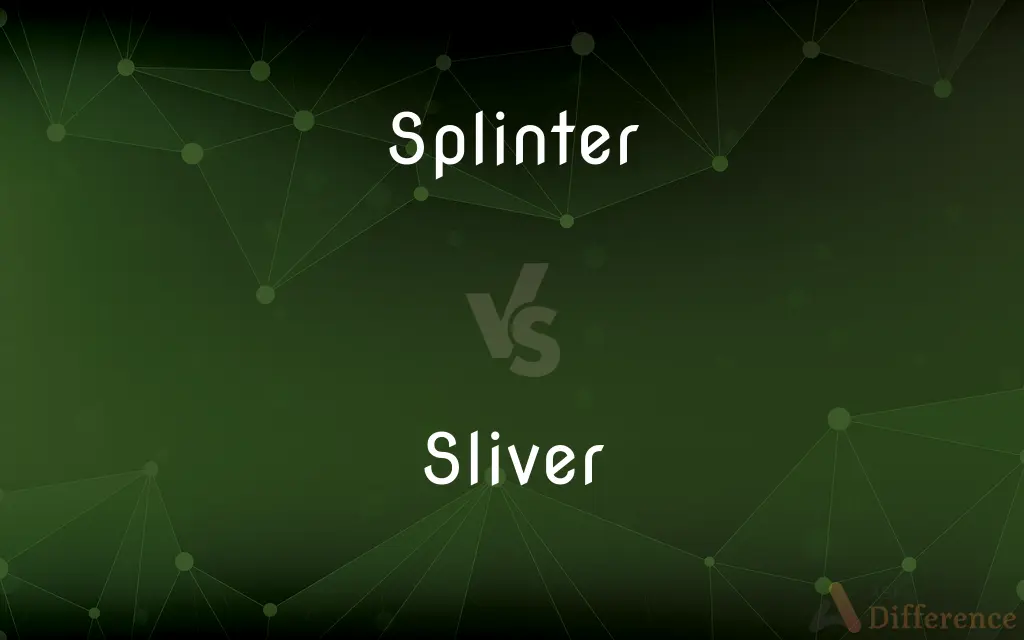Splinter vs. Sliver — What's the Difference?
By Fiza Rafique & Urooj Arif — Updated on March 18, 2024
Splinters are small, sharp fragments, typically wood, piercing the skin, while slivers are thin, long pieces, not necessarily sharp or skin-penetrating.

Difference Between Splinter and Sliver
Table of Contents
ADVERTISEMENT
Key Differences
Splinters are usually pieces of wood, metal, glass, or other materials that break off from a larger object and are sharp enough to penetrate the skin, often causing pain or discomfort. They're commonly associated with woodworking or walking barefoot on wooden surfaces. Whereas slivers are thin, often elongated pieces of material like wood, metal, or glass. While they can be sharp, slivers are not always defined by their ability to penetrate the skin but more by their shape and thinness.
Splinters can cause immediate discomfort or pain upon entering the skin, leading to a need for removal to prevent infection or further injury. They are often encountered accidentally. On the other hand, slivers may not always cause injury but can be annoying or cause minor irritation depending on where they are found or how they are handled.
The term "splinter" often implies a fragment that has broken off abruptly, suggesting a forceful or accidental separation from the main body. This implies a certain degree of roughness or abruptness in the break. Conversely, "sliver" implies a piece that is naturally thin or has been sliced thinly, suggesting a more delicate or precise separation, whether intentional or accidental.
In medical or first-aid contexts, dealing with splinters often requires sterilized tools for safe removal to prevent infection, emphasizing the care needed to address the potential harm they can cause. Slivers, if not causing discomfort or injury, may not require immediate medical attention but can be removed for comfort or to prevent potential problems.
Despite their differences, both splinters and slivers require careful handling to prevent injury or further complications. Whether dealing with a sharp splinter embedded in the skin or a thin sliver that may cause irritation, the approach to handling these objects is guided by the principle of minimizing harm and preventing infection.
ADVERTISEMENT
Comparison Chart
Definition
A small, sharp piece of wood, metal, or other material that breaks off and can penetrate the skin.
A thin, often elongated piece of material that may not necessarily be sharp or penetrating.
Common Source
Wood, metal, glass
Wood, metal, glass
Associated Action
Penetrating the skin, causing discomfort or pain.
Causing irritation or minor discomfort, not necessarily by penetrating the skin.
Removal
Often requires sterilized tools and care to prevent infection.
May not require medical attention unless causing discomfort or risk.
Implication of Formation
Implies a forceful or accidental break.
Suggests a delicate or precise separation.
Compare with Definitions
Splinter
A small, sharp fragment of material that has broken off from a larger object, often penetrating the skin.
He got a splinter in his finger while moving the old wooden furniture.
Sliver
Can be a result of both intentional and accidental separation from a larger piece.
She enjoyed putting slivers of almond on top of her morning oatmeal.
Splinter
A piece of wood, metal, or glass that can cause pain when embedded in the skin.
Removing a splinter requires tweezers and patience.
Sliver
A thin, narrow piece of material, often found when slicing or cutting.
A sliver of glass got stuck in her hand while she was cleaning up the broken vase.
Splinter
Associated with accidental injury or the need for careful removal.
After getting a splinter, he learned to be more careful when handling wood.
Sliver
Not necessarily sharp, but can be irritating if handled improperly.
He found a sliver of metal in the machine, which explained the malfunction.
Splinter
A term often used to describe a fragment that can lead to discomfort if not removed.
She felt a splinter pierce her foot as she walked across the wooden deck.
Sliver
May not cause immediate harm but requires attention to prevent irritation.
Removing a sliver from your eye requires utmost care to avoid damage.
Splinter
Indicates a piece that has broken off abruptly or forcefully.
The broken bat sent splinters flying into the air.
Sliver
Emphasizes the shape and thinness of the piece rather than its ability to penetrate.
The light shone through a sliver of the curtain, illuminating the room.
Splinter
A splinter (also known as a sliver) is a fragment of a larger object, or a foreign body that penetrates or is purposely injected into a body. The foreign body must be lodged inside tissue to be considered a splinter.
Sliver
A slender piece cut, split, or broken off; a splinter
Slivers of broken glass.
Splinter
A sharp, slender piece, as of wood, bone, glass, or metal, split or broken off from a main body.
Sliver
A small narrow piece, portion, or plot
A sliver of land.
Splinter
A splinter group.
Sliver
A continuous strand of loose fiber, such as wool, flax, silk, or cotton, ready to be roved or spun.
Splinter
To split or break into sharp, slender pieces; form splinters.
Sliver
To split or become split into slivers.
Splinter
To cause to splinter.
Sliver
A long piece cut or rent off; a sharp, slender fragment; a splinter.
Splinter
A long, sharp fragment of material, often wood.
Sliver
(regional US) Specifically, a splinter caught under the skin.
Splinter
A small such fragment that gets embedded in the flesh.
Sliver
A strand, or slender roll, of cotton or other fiber in a loose, untwisted state, produced by a carding machine and ready for the roving or slubbing which precedes spinning.
Splinter
A group that formed by splitting off from a larger membership.
Sliver
(fishing) Bait made of pieces of small fish. Compare kibblings.
Splinter
(bridge) A double-jump bid which indicates shortage in the bid suit.
Sliver
A narrow high-rise apartment building.
Splinter
(intransitive) To come apart into long sharp fragments.
The tall tree splintered during the storm.
Sliver
A small amount of something; a drop in the bucket; a shred.
Splinter
(transitive) To cause to break apart into long sharp fragments.
His third kick splintered the door.
Sliver
(transitive) To cut or divide into long, thin pieces, or into very small pieces; to cut or rend lengthwise; to slit.
To sliver wood
Splinter
To break, or cause to break, into factions.
The government splintered when the coalition members could not agree.
The unpopular new policies splintered the company.
Sliver
To cut or divide into long, thin pieces, or into very small pieces; to cut or rend lengthwise; to slit; as, to sliver wood.
They 'll sliver thee like a turnip.
Splinter
(transitive) To fasten or confine with splinters, or splints, as a broken limb.
Sliver
A long piece cut or rent off; a sharp, slender fragment, as of glass; a splinter.
Splinter
To split or rend into long, thin pieces; to shiver; as, the lightning splinters a tree.
After splintering their lances, they wheeled about, and . . . abandoned the field to the enemy.
Sliver
A strand, or slender roll, of cotton or other fiber in a loose, untwisted state, produced by a carding machine and ready for the roving or slubbing which preceeds spinning.
Splinter
To fasten or confine with splinters, or splints, as a broken limb.
Sliver
Bait made of pieces of small fish. Cf. Kibblings.
Splinter
To become split into long pieces.
Sliver
A small thin sharp bit or wood or glass or metal;
He got a splinter in his finger
It flew into flinders
Splinter
A thin piece split or rent off lengthwise, as from wood, bone, or other solid substance; a thin piece; a sliver; as, splinters of a ship's mast rent off by a shot.
Sliver
A thin fragment or slice (especially of wood) that has been shaved from something
Splinter
A small thin sharp bit or wood or glass or metal;
He got a splinter in his finger
It flew into flinders
Sliver
Divide into slivers or splinters
Splinter
Withdraw from an organization or communion;
After the break up of the Soviet Union, many republics broke away
Sliver
Break up into splinters or slivers;
The wood splintered
Splinter
Divide into slivers or splinters
Sliver
Form into slivers;
Sliver wood
Splinter
Break up into splinters or slivers;
The wood splintered
Common Curiosities
What is a splinter?
A splinter is a small, sharp piece of material, such as wood, metal, or glass, that has broken off and can penetrate the skin, causing discomfort or pain.
What is a sliver?
A sliver is a thin, often elongated piece of material that may not necessarily be sharp or penetrating but can cause irritation or minor discomfort.
Can slivers cause injury?
While slivers may not always penetrate the skin, they can cause irritation or discomfort, especially if they come into contact with sensitive areas.
Are splinters and slivers the same?
No, splinters and slivers differ primarily in their shape and the potential for causing injury. Splinters are sharp and can penetrate the skin, while slivers are thin and elongated, not necessarily causing penetration.
Can both splinters and slivers come from glass?
Yes, both splinters and slivers can come from glass, especially when it breaks or shatters, creating sharp fragments and thin pieces.
How can I prevent getting splinters?
Preventing splinters involves wearing protective clothing when handling wood or walking in areas where splinters are likely and being cautious around potential sources.
How do you remove a splinter?
Removing a splinter often involves using sterilized tweezers to gently pull the splinter out of the skin, followed by cleaning the area to prevent infection.
Can slivers be found in food?
Yes, slivers, especially of hard materials like bone or shells, can sometimes be found in food and should be removed before consumption.
What is the difference in pain between a splinter and a sliver?
Splinters, due to their ability to penetrate the skin, often cause more immediate pain or discomfort than slivers, which may cause irritation depending on their location and size.
Where do splinters commonly occur?
Splinters commonly occur when handling wood, walking barefoot on wooden surfaces, or when in contact with broken glass or metal.
Can a sliver turn into a splinter?
While the terms describe different forms, a thin sliver could be considered a splinter if it's sharp enough to penetrate the skin.
What should you do if you can't remove a splinter?
If you're unable to remove a splinter, it's recommended to seek medical attention to prevent infection or further injury.
Is it necessary to remove every sliver?
While not every sliver may require removal, it's often done for comfort or to prevent potential irritation or injury.
Do all splinters need to be removed immediately?
While not all splinters pose immediate danger, prompt removal is advised to prevent infection or further discomfort.
What are the risks of leaving a splinter untreated?
Leaving a splinter untreated can lead to infection, pain, and potentially more serious health issues if not addressed.
Share Your Discovery

Previous Comparison
Coenzyme vs. Cofactor
Next Comparison
Diffusion vs. EffusionAuthor Spotlight
Written by
Fiza RafiqueFiza Rafique is a skilled content writer at AskDifference.com, where she meticulously refines and enhances written pieces. Drawing from her vast editorial expertise, Fiza ensures clarity, accuracy, and precision in every article. Passionate about language, she continually seeks to elevate the quality of content for readers worldwide.
Co-written by
Urooj ArifUrooj is a skilled content writer at Ask Difference, known for her exceptional ability to simplify complex topics into engaging and informative content. With a passion for research and a flair for clear, concise writing, she consistently delivers articles that resonate with our diverse audience.















































